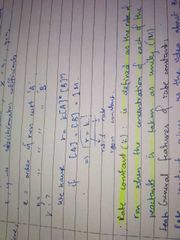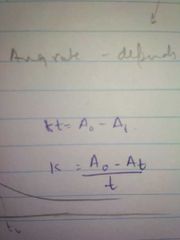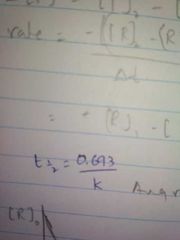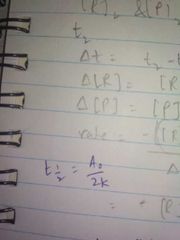![]()
![]()
![]()
Use LEFT and RIGHT arrow keys to navigate between flashcards;
Use UP and DOWN arrow keys to flip the card;
H to show hint;
A reads text to speech;
21 Cards in this Set
- Front
- Back
|
Chemical kinetics |
Branch of chemistry that deals with study if reaction rates and their mechanisms. |
|
|
Chemical kinetics also tells us abt the conditions by which rxn rates can be altered. What are those conditions? |
• concentration •temperature •pressure •catalyst |
|
|
Rate of reaction |
Change in concentration of reactant or product in unit time.
It can be expressed in terms of: - rate of decrease in conc. of any one of the reactants - rate of increase in conc. of any 1 of the products. |
|
|
Units of rate of a rxn |
r= Molar conc./time = mol L-¹ s-¹ For gaseous rxns , when conc. is expressed in terms of partial pressures r= atm/s |
|
|
Rate law |
Representation of ROR in terms of conc. of reactants. Aka rate expression/equation. |
|
|
Rate law |
Representation of ROR in terms of conc. of reactants.
Aka rate expression/equation. Rate law can't be predicted by merely looking at the balanced chemical equation(theoretically) but MUST be determined experimentally. |
|
|
Rate law |
Expression in which the reaction rate is given in terms of molar concentration of reactants with each term raised to some power, (which may or may not be equal to the stoich. coefficient of the reacting species in a balanced chemical equation). |
|
|
Write the differential form of rate expression |
-d[R]/dt = k[A]* [B]' Where *(= order of reaction wrt reactant A) and '(=order of rxn wrt B) may or may not be equal to their respective stoichiometric coefficient. |
|
|
Order of a rxn |
Sum of power of the conc. of reactants in the rate law expression. Indicates how sensitive the rate of rxn is to the change in conc. of reactants. Can be 0,1,2,3 and even a fraction. |
|
|
Elementary reactions |
Rxns that take place in 1 step |
|
|
Complex reactions |
When a sequence of 1° rxns gives us the products. These may be consecutive reactions, reverse reactions and side reactions. |
|
|
Units of rate constant |
k = Rate/ [A]*[B]° |
|
|
Molecularity of a reaction |
Number of reacting species (atoms,ions or molecules) taking part in an elementary reaction, which must collide simultaneously in order to bring about a chemical rxn. Rxn can be unimolecular, bimolecular (involves simultaneous collision b/w 2 species) , trimolecular involves simultaneous collision b/w 3 reacting species) |
|
|
Fact about molecularity |
The probability of more than 3 molecules to collide simultaneously is very small. i.e. probability of molecularity to be more than 3 is very less. |
|
|
Overall rate of a complex reaction |
Determined by the slowest elementary step in the complex reaction And is called rate determining step. |
|
|
Rate constant |

Is the rate of rxn when the conc of each of the reactants is taken as unity. It changes in changing the temperature of the rxn
|
|
|
Half life of a reaction |
Is the time in which the concentration of a reactant is reduced to half of its initial concentration. |
|
|
Integrated expression for Zero order reaction |

Initial minus final |
|
|
Integrated rate equation for First order reaction |

|
|
|
Half life of FOR |

0.693/k |
|
|
Half life of ZOR |

Unlike FOR, half life of ZOR depends on initial concentration of reactant. |

